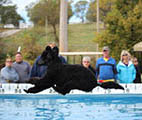Overview of Epilepsy
Idiopathic epilepsy (also called “primary epilepsy” or “inherited epilepsy”) can occur in all varieties of Poodles, as well as at least 25 or 30 other breeds of dogs. However, there are many factors that can cause seizures in dogs (or people) besides idiopathic epilepsy. These include a wide variety of metabolic disorders (such as liver disorders), infectious diseases that affect the brain (such as distemper, toxoplasmosis), tumors, exposure to poisons, severe head injuries, and more. Whenever a dog has seizures, it is advisable for the dog to receive a thorough diagnostic work-up. If none of the examinations or laboratory tests shows anything abnormal, then by process of exclusion, the dog will be diagnosed as having idiopathic epilepsy. With idiopathic epilepsy, it generally is assumed that the dog has inherited the tendency to have seizures.
No one can make any guarantees, and there are exceptions to all rules, but when a poodle has idiopathic epilepsy, the prognosis generally is very good. The majority of these dogs live long and happy lives. The prognosis for seizures due to other disorders varies depending on the particular disorder and how early it is diagnosed.
For some dogs with epilepsy, the seizures will be sufficiently infrequent (one or two per year) that no treatment is required, unless the seizures are extremely long or occur in clusters. Currently, there is no consensus concerning when treatment should begin. Many veterinarians suggest that treatment should begin if the dog is having at least one seizure per month. However, others suggest that treatment should begin much sooner (for example, if the dog is having one seizure every 3 months). Recent research suggests that the long-term prognosis is better when the individual begins treatment before the seizures become too frequent. This is because the brain seems to “get used to” having seizures, which makes the seizures more difficult to control when you do start treatment. Thus, you should work closely with a veterinarian that you trust in making the difficult decision of when to start treatment.
A number of owners and veterinarians prefer to try non-traditional (“alternative”) approaches to controlling seizures. These include diets, herbal remedies, acupuncture, gold bead implants (a permanent form of acupuncture), amino acids, hormones, etc. Some owners and veterinarians report that some of these remedies help a lot, but others report that they do not. Unfortunately, there is no scientific evidence to support their effectiveness. Like drugs, some of these can have negative side effects. So whether you chose traditional medication or alternative treatments, careful monitoring is necessary.
For those who require treatment, there are two very good anticonvulsant (anti-seizure) drugs that are effective with dogs: Phenobarbital (PB) and Bromide. (See Treatment of Seizures: Phenobarbital versus Potassium Bromide.) Bromide is administered either as Potassium Bromide (KBr) or Sodium Bromide (NaBr). For years, Phenobarbital has been the medication of choice, and KBr was either added or substituted when a dog did not respond well enough to Phenobarbital or when a dog had liver problems. (Phenobarbital is metabolized by the liver and can cause some liver problems. However, if you monitor the liver regularly, you generally will catch problems before they become serious.) Some veterinarians prefer to use KBr first because it does not cause liver problems, although some veterinarians suspect that it may increase the chances of pancreatitis. Regardless of which medication is used, it is important to regularly monitor to determine if the level of the drug in the dogs blood is within the “therapeutic range” (that is, high enough to control seizures, but not too high to cause serious side effects). Although there are many other drugs that are effective with humans, most of these do not work on dogs because the dog’s liver metabolizes them too quickly. They also are more expensive than Phenobarbital or Bromide. However, if neither of these drugs works well on your dog, there are some other alternatives that do seem to work well with dogs.
There is an excellent website on canine epilepsy that covers a broad range of topics. It is written by epilepsy experts at the University Of Missouri Veterinary Teaching College. The address is:
http://www.canine-epilepsy.net/
After you get there, click on “Canine Epilepsy Basics” for general information on epilepsy.
©Barbara G. Licht PhD, 2010
Used with Permission
Updated 3/1/2010
The information contained in these documents is current at the time of this writing and is accurate to the best of VIP’s knowledge.
This information has been provided to you at no charge. You are free to use it provided it is used in its entirety with no changes or alterations and that the copyright remains intact. If you have found this information to be helpful, please consider making a tax-deductible donation to:
Versatility in Poodles
4061 Highlands Rd
Franklin, NC 28734
To make a donation via PayPal, please click the Donate Button:
The contents of the www.vipoodle.org website, such as text, graphics, images, and other material contained on this site (“Content”) are for informational purposes only. The Content is not intended to be a substitute for professional veterinarian advice, diagnosis, or treatment. Always seek the advice of your veterinarian with any questions you may have regarding the medical condition of your pet. Never disregard professional advice or delay in seeking it because of something you have read on this website!
If you think your pet has a medical emergency, call or visit your veterinarian or your local veterinary emergency hospital immediately. Versatility in Poodles and www.vipoodle.org do not recommend or endorse any specific veterinarians, products, procedures, opinions, or other information that may be mentioned on this website. Reliance on any information appearing on this website is entirely at your own risk.















